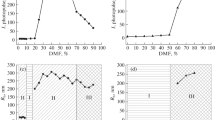Abstract
We report a study of the effects of polymer molecular weight on the erosion of polyanhydride copolymer matrices composed of 1,3-bis (p-carboxyphenoxy)-propane (CPP) and sebacic acid (SA) in aqueous solution. The erosion profile characteristically displays an induction period during which the erosion rate is relatively slow. The length of this period depends on the initial molecular weight of the polymer. The induction period may be characterized as a time during which a rapid decrease in polymer molecular weight occurs, the end of this period correlating with the time required for the polymer molecular weight to decrease to below a value of approximately 5000 (MW).
Similar content being viewed by others
REFERENCES
K. W. Leong, B. C. Brott, and R. Langer. Bioerodible polyanhydrides as drug-carrier matrices. I. Characterization, degradation and release characteristics. J. Biomed. Mat. Res. 19:941–955 (1985).
S. J. Holland, B. J. Tighe, and P. L. Gould. Polymers for biodegradable medical devices, part I. J. Control. Release 4:155–180 (1986).
F. G. Hutchinson and B. J. A. Furr. Drug carrier systems. In F. H. D. Roerdink and A. M. Kroon (eds.), Biodegradable Polymers for Controlled Release of Peptides and Proteins, John Wiley and Sons, Chichester, 1989, pp. 111–127.
R. Langer and M. Chasin. In R. Langer and M. Chasin (eds.), Biodegradable Polymers as Drug Delivery Systems, Marcel Dekker, New York, 1990, pp. 43–70.
J. P. Kitchell and D. L. Wise. Poly(lactic/glycolic acid) biodegradable drugpolymer matrix systems. Meth. Enzymol. 112 (Drug Enzyme Targeting, Pt. A):436–448 (1985).
M. Chasin, D. Lewis, and R. Langer. Polyanhydrides for controlled drug delivery. Biopharm. Manuf. 1:33–39 (1988).
K. W. Leong, P. D'Amore, M. Marletta, and R. Langer. Bioerodible polyanhydrides as drug-carrier matrices: II: Biocompatibility and chemical reactivity. J. Biomed. Mater. Res. 20:51–64 (1986).
M. Chasin, A. Domb, E. Ron, E. Mathiowitz, R. Langer, K. Leong, C. Laurencin, H. Brem, and S. Grossman. Polyanhydrides as drug delivery systems. In M. Chasin and R. Langer (eds.), Biodegradable Polymers as Drug Delivery Systems, Marcel Dekker, New York, 1990, pp. 43–69.
A. Domb and R. Langer. Solid-state and solution stability of polyesters and polyanhydrides. Macromolecules 22:2117 (1989).
H. G. Rosen, J. Chang, G. Wnek, R. Linhardt, and R. Langer. Bioerodible polyanhydrides for controlled drug delivery. Biomaterials 4:131–133 (1983).
K. Leong, J. Kost, E. Mathiowitz, and R. Langer. Polyanhydrides for the controlled release of bioactive agents. Biomaterials 7: 364–371 (1986).
A. D'Emanuele, J. Kost, J. Hill, and R. Langer. The investigation of the effects of ultrasound on degradable polyanhydride matrices. Macromolecules 25:511–515 (1992).
J. Tamada and R. S. Langer. Mechanism of the erosion of polyanhydride drug delivery systems. Proc. Int. Symp. Control. Rel. Bioact. Mater. 17, Controlled Release Society, Lincolnshire, IL, 1990, paper D305.
H. Fukuzaki, H. Yoshida, M. Asano, M. Kumakura, T. Mashimo, H. Yuasa, K. Imai, and H. Yamanaka. In vivo characteristics of low-molecular-weight copoly(L-lactic acid/DL-hydroxyisocaproic acid) with parabolic-type and s-type degradation patterns. Makromol. Chem. 191:731–736 (1990).
Y. Doi, Y. Kanesawa, M. Kunioka, and T. Saito. Biodegradation of microbial copolyesters: Poly(3-hydroxybutyrate-CO-3-hydroxyvalerate) and poly(3-hydroxybutyrate-CO-4-hydroxybutyrate). Macromolecules 23:26–31 (1990).
S. J. Holland, A. M. Jolly, M. Yasin, and B. J. Tighe. Polymers for biodegradable medical devices, Part II. Biomaterials 8:289–295 (1987).
S. J. Holland, M. Yasin, and B. J. Tighe. Polymers for biodegradable medical devices, Part VII. Biomaterials 11:206–215 (1990).
H. T. Wang, H. Palmer, R. J. Linhardt, D. R. Flanagan, and E. Schmitt. Degradation of poly(ester) microspheres. Biomaterials 11:679–685 (1990).
C. G. Pitt. Poly-ε-caprolactone and its copolymers. In M. Chasin and R. Langer (eds.), Biodegradable Polymers as Drug Delivery Systems, Marcel Dekker, New York, 1990, pp. 71–120.
Author information
Authors and Affiliations
Rights and permissions
About this article
Cite this article
D’Emanuele, A., Hill, J., Tamada, J.A. et al. Molecular Weight Changes in Polymer Erosion. Pharm Res 9, 1279–1283 (1992). https://doi.org/10.1023/A:1015801216466
Issue Date:
DOI: https://doi.org/10.1023/A:1015801216466




